
Bull cults were popular from at least the First Dynasty (Early Dynastic Period). The powerful and virile bull was associated with the pharaoh, who sometimes took the epithet “strong bull of his mother”. As early as 3100 BC the king is depicted in the form of a bull. A sacred bull was identified by specific sacred markings. Once the bull had been confirmed as the incarnation of a god, it was housed in plush quarters, given only the best food, and provided with a harem of the best cows. The lucky animal would live in the lap of luxury until its death when it would be mummified and buried with full honours.
Apis Bull
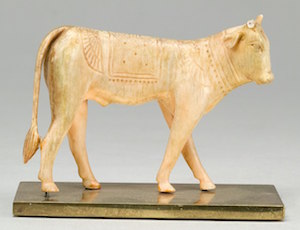
The most famous of the bull cults is undoubtedly that of the Apis bull (also known as the Hapis Bull or “Hapi-ankh”). The bull was the incarnation of a god, but unlike the other animal totems (who only provided a link to the god) the Apis was thought to host the god himself. The Apis bull was originally viewed as the manifestation of Ptah. However, the Apis was soon linked to Osiris when Ptah and Osiris merged and so Plutarch described the Apis as the “fair and beautiful image of the soul of Osiris”. According to one myth, the Apis was the living embodiment of Ptah while he lived and Osiris when he died.
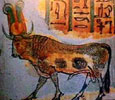
The discovery of an Apis was always cause for a celebration. Herodotus claimed that the Persian King Cambyses was annoyed that the Egyptians held a celebration the day after he defeated them in battle. When he discovered that they were celebrating the birth of a god, he demanded to see the god immediately. The Apis was brought to him and he killed and ate the bull, to the horror of the Egyptians. However, Egyptian records suggest that Cambyses actually took part in the ceremony recognising the Apis, so the story is probably more symptomatic of the Egyptians general dislike of the Persian rulers.
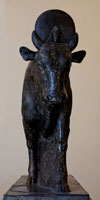
An Apis calf was black with a white diamond on its forehead, an image of an eagle on its back, double the number of hairs on its tail, and the sign of a scarab under its tongue. It was thought that a flash of lightning struck the cow causing her to conceive the Apis, but that from that time she would never again bear any young.
The mother of an Apis was held in great regard, and given the title “Isis cow”. There could only be one Apis at a time. The search for a replacement bull would begin with the death of the current Apis. The new Apis was transported to Memphis on a decorated boat built specifically for the purpose.
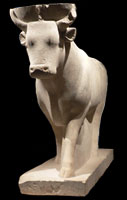
When an Apis bull died, the body was embalmed and buried with full honours in the manner befitting royalty. The animal was carefully embalmed and mummified before being interred in the “Serapeum” in a stone sarcophagus that could weigh over 60 tons.
The Festival of the Apis Bull lasted for seven days. The sacred bull was led through the streets as the people cheered. According to legend, any child who smelled the breath of the Apis would be able to read the future as the Apis was thought to be a powerful oracle.
During the Ptolemiac Period a new god named Serapis was devised to try to bring the Greek and Egyptian people together. Serapis absorbed some of the attributes of Zeus, Asklepios, and Dionysus and merged them with some of the attributes of Osiris and some of the attributes of the Apis. However, although the Greek settlers were fond of this hybrid god, Serapis was never really accepted by the native Egyptians.
Buchis Bull
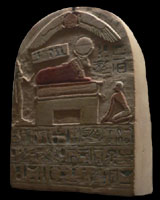
The cult Buchis (Bekh, Bakha, Bakh) was also popular. The bull had a black face and a white body and was thought to be a manifestation of the Ka (life-force) of the war god Montu (Montju), worshipped in the region of Hermonthis. The cult was also associated with Ra and to a lesser extent, Osiris. The bull’s name is a reference to the “Ba” and “Akh”, two of the parts of the Ka. Ka is also the Egyptian word for bull.
The cult was centered around Armant where generations of mummified bulls and their mothers were interred in the “Bucheum”. The tombs of the Buchis were similar to those of the Apis, but the structures were topped by vaulted roof rather than carved into the living rock.
Some of the tombs contained a large store of funerary equipment, while others contained only the mummy of the Buchis. Some of the more recent Buchis mummies were interred in the passages which linked the older tombs, and all of the burials date from the Late Period.
Mnevis Bull
The Mnevis (Meruur or Mnewer) was the sacred bull of Heliopolis. The bull was usually completely black, but if that was not possible a white bull was also acceptable. The chosen bull was also known as “Kemwer” (“great black”). In time, the bull came to be associated with the more popular Apis bull.
![Mnevis Bull Louvre Museum [CC BY-SA 2.0 fr (https://creativecommons.org/licenses/by-sa/2.0/fr/deed.en)]](https://ancientegyptonline.co.uk/wp-content/uploads/2019/06/Mnevis.jpg)
The bull was associated with Ra and possibly also with Min. When Akhenaten abandoned the other gods in favour of the Aten he claimed that he would maintain the Mnevis cult. The cult may have retained his favour because of its solar associations, but archaeologists have not discovered any indication that the pharaoh made good his promise.
There is very little information regarding the Mnevis cult. Only two Mnevis burials have been discovered, dating from the reigns of Ramesses II and Ramesses IV (during the New Kingdom) interred in individual tombs cut into the ground and topped by a huge granite slab. The burials included a set of Canopic Jars which seem to have been purely ritualistic as they were found to be empty.
Bibliography
- Bard, Kathryn (2008) An introduction to the Archaeology of Ancient Egypt
- Grajetzki, W (2003) Burial Customs in Ancient Egypt
- Kemp, Barry J (1991) Ancient Egypt: Anatomy of a Civilisation
- Pinch, Geraldine (2002) Handbook Egyptian Mythology
- Redford Donald B (2002) Ancient Gods Speak
- Wilkinson, Richard H. (2003) The Complete Gods and Goddesses of Ancient Egypt
- Wilkinson, Richard H. (2000) The Complete Temples of Ancient Egypt
Copyright J Hill 2010